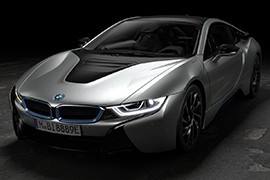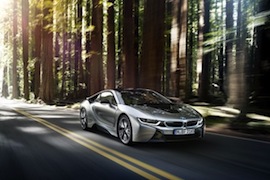BMW i8 Models/Series Timeline, Specifications & Photos
First production year: 2014
Engines: Hybrid
Body style: Coupé (two-door)
BMW refreshed the i8 sports car after four years since it introduced the model into its range. Besides the exterior update, it also brought significant changes to the drivetrain.
The German carmaker surprised the market with the i8 sports car. It was unlike anything else in its stable and offered the best of both worlds: performance and fuel efficiency. It also boasted several carbon fiber elements and an astonishing, comfortable, and luxurious interior.
While the car's overall shape remained unchanged, some details differentiated the 2018 model year from its non-facelifted version. For starters, the headlights featured slightly modified LED daytime running lights. The coupe also received a set of “coupe” badges placed on the C-pillars since the car also became available as a roadster. In addition, BMW introduced a new set of 20” light-alloy wheels on the options list.
Inside, BMW offered ceramic, or carbon fiber trims on the options list, which was a first for the i8. In addition, the automaker offered a new, copper-colored upholstery. The 2018 model came with a touchscreen for the infotainment system, complementing the iDrive unit. Moreover, the head-up display received a shift-light function for the rare occasions when the driver wanted to manually change gears.
But the most important changes were under the skin. First, the battery size increased from 20 to 34 Ah, resulting in a longer EV mode of up to 55 km (34 miles). Thanks to this upgrade, the automaker could also increase the electric motor performance to 105 kW/143 hp. Last but not least, the turbocharged inline-three was used mostly to replenish the battery pack and less for moving the vehicle.
The BMW i8 was more of a showcase than a sports car. Its appearance shocked the world since it has the smallest internal combustion engine installed on a car that could get you from 0 to 100 kph (62 mph) in 4.4 seconds and carry on up to 250 kph (155 mph). But the car was a masterpiece of engineering.
The sleek aerodynamic 2+2 coupe vehicle was a plug-in hybrid. It was launched where car manufacturers didn't want to risk too much on the recovering market after the world economic crisis. But BMW didn't care. They built something incredible. A low-weight vehicle, with a sports car look, enough elegance and claimed it is more of a daily-driver GT than a supercar.
Under the hood, there were a 1.5-liter turbocharged, 3 cylinders from a MINI that offers 230 hp. On the front axle, there was an electric motor that offered 130 hp. The result is a sportscar able to battle against a Porsche 911 with the fuel consumption of a cheap city car. The bodywork was made out of carbon-reinforced plastic (CFRP) and aluminum. These materials were taken from the racing department because they are very light and offer enough strength.
The sci-fi look of the car is continued with the laser headlights that can light-up 600 meters (2968 ft) ahead on the road.

